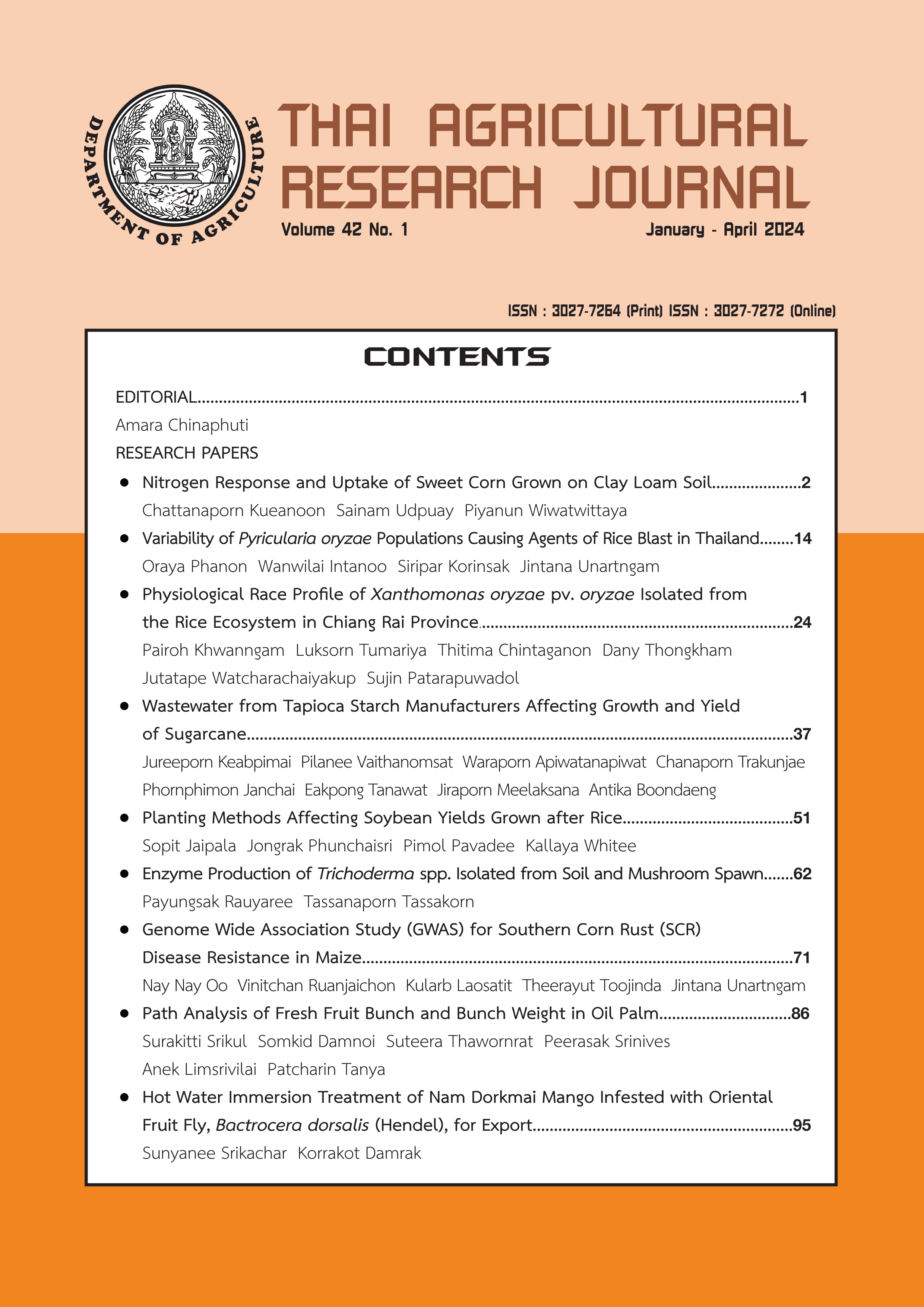Variability of Pyricularia oryzae Populations Causing Agents of Rice Blast in Thailand
DOI:
https://doi.org/10.14456/thaidoa-agres.2024.2Keywords:
blast disease, Pyricularia oryzae, population., diversity, riceAbstract
Rice blast, caused by Pyricularia oryzae, is an important disease of rice production in Thailand. This disease is distributed in all localities of the country. It affects the quality and quantity of rice production. The purpose of this research was to evaluate the variation of P. oryzae populations collected from major rice growing areas of the country by studying their pathogenicity towards 9 differential rice varieties that had single resistance genes (near isogenic lines; NILs): Pi-7(t), Pi9, Pi-a, Pi-b, Pi-i, Pi-kh, Pi-t, Pi-ta and Pi-sh. Results revealed that from the 80 isolates studied, the pathogen could be identified into 47 races. When all isolates were clustered by UPGMA methods Past 4.10 program by using disease index data, the classical clustering analysis showed that P. oryzae races were grouped into 13 clades with cophenetic correlation at 0.80. However, race identification and clustering were not correlated with the sources of P. oryzae, more than one race could occur in one site. The results indicated that pathogenicity of the fungus was variable within the population as well as among populations. These results were informative for the planning of improvement of blast disease resistant rice varieties.
References
กระทรวงเกษตรและสหกรณ์. 2562. สถานการณ์ศัตรูพืชระบาด. แหล่งข้อมูล: http://www.moac.go.th. สืบค้น: 15 กรกฎาคม 2566.
พูนศักดิ์ เมฆวัฒนากาญจน์ และวีณา เมฆวัฒนากาญจน์. 2559. โรคไหม้ของข้าว. โรงพิมพ์มหาวิทยาลัยอุบลราชธานี, อุบลราชธานี.
พูนศักดิ์ เมฆวัฒนากาญจ์ พยอม โคเบลลี่ อัจฉราพร ณ ลำปาง เนินพลับ ถนอมจิตร์ ฤทธิ์มนตรี กุลชนา เกศ สุวรรณ ชนสิริน กลิ่นมณี และสงวน เที่ยงดีฤทธิ์. 2550. การตรวจสอบความหลากหลายของสายพันธุ์ เชื้อราสาเหตุโรคไหม้ข้าวในประเทศไทย. วารสารวิชาการข้าว. 1(1): 52-64.
สมคิด ดิสถาพร. 2532. ชาวนาปราบโรคข้าว. สมาคมนักโรคพืชแห่งประเทศไทย. 116 หน้า.
เสาวลักษณ์ อัคราช ประภา ศรีพิจิตต์ และธานี ศรีวงศ์ชัย. 2554. การวิเคราะห์จัดกลุ่มความต้านทานเชื้อโรค ไหม้ของข้าวพันธุ์ปรับปรุงด้วยเชื้อที่เก็บรวบรวมใหม่. หน้า 581-588. ใน: เรื่องเต็มการประชุมทางวิชาการของมหาวิทยาลัยเกษตรศาสตร์ ครั้งที่ 49 สาขาพืช. กรุงเทพฯ.
นวรัตน์ ใจหอม และนงลักษณ์ เภรินทวงค์. 2557. การประเมินความหลากหลายและการจัดกลุ่มความรุนแรงของเชื้อราสาเหตุโรคไหม้ข้าวที่เก็บรวบรวมในประเทศไทย. หน้า 71-78. ใน: เรื่องเต็มการประชุมทางวิชาการของมหาวิทยาลัยเกษตรศาสตร์ ครั้งที่ 52: สาขาพืช. 2557. กรุงเทพฯ.
Apinya, L., T. Sucheela and J. Chatchawan. 2020. Morphological characterization and genetic diversity of rice blast fungus, Pyricularia oryzae, from Thailand using ISSR and SRAP markers. Journal of Fungi. 6(1): 38.
Bonman, J.M. 1992. Blast. pp 14–17. In: Webster, R.K. and P.S. Gunnell (eds). Compendium of Rice Diseases. APS Press, St. Paul.
CAB International, Wallingford, Oxon, U.K.
Disthaporn, S. 1994. Current rice blast epidemics and their management in Thailand. pp. 333-342. In: R.S. Zeigler, S.A. Leong and P.S. Teng (eds.). Rice Blast Disease.
Jones, J.D.G. and J.L. Dangl. 2006. The plant immune system. Nature. 444: 323–329.
Koizumi, S. 2008. Durability of resistance to rice blast disease. pp 1-10. In: Differential Systems for Blast Resistance for Stable Rice Production Environment. Technical Report Vol. 53. Y. Fukuta, C.M. Vera Cruz and N. Kobayashi. (eds.) Japan International Research Center for Agricultural Sciences (JIRCAS). Tsukuba, Ibaraki, Japan.
McMaugh, T. 2008. Guidelines for surveillance for plant pests in Asia and the Pacific. The Australian Centre for International Agricultural Research (ACIAR) Monograph 119, 199 p.
Mekwatanakarn, P., W. Kositratana, M. Levy and R.S. Zeigler. 1999. Sexual fertile Magnaporthe grisea rice pathogens in Thailand. Plant Disease. 83(10): 939-943.
Mekwatanakarn, P., W. Kositratana, M. Levy and R.S. Zeigler. 2000. Pathotype and avirulence gene diversity of Pyricularia grisea in Thailand as determined by rice lines near-isogenic for major resistance genes. Plant Disease. 84(1): 60-70.
Roumen, E., M. Levy and J.L. Notteghem. 1997. Characterization of the European pathogen population of Magnaporthe grisea by DNA finger printing and pathotype analysis. European Journal of Plant Pathology. 103: 363-371.
Zeigler, R.S., L.X. Cuoc, R.P. Scott, M.A. Bernardo, D.H. Chen, B. Valent and R.J. Nelson. 1995. The relationship between lineage and virulence in Pyricularia grisea in the Philippines. Phytopathology. 85: 443-451.
Zhou, E., Y. Jia, P. Singh, J.C. Correll and F.N. Lee. 2007. Instability of the Magnaporthe oryzae avirulence gene AVR-Pita alters virulence. Fungal Genetics and Biology. 44(10): 1024–1034.
Downloads
Published
How to Cite
Issue
Section
License
Copyright (c) 2024 Thai Agricultural Research Journal

This work is licensed under a Creative Commons Attribution-NonCommercial-NoDerivatives 4.0 International License.
Thai Agricultural Research Journal



